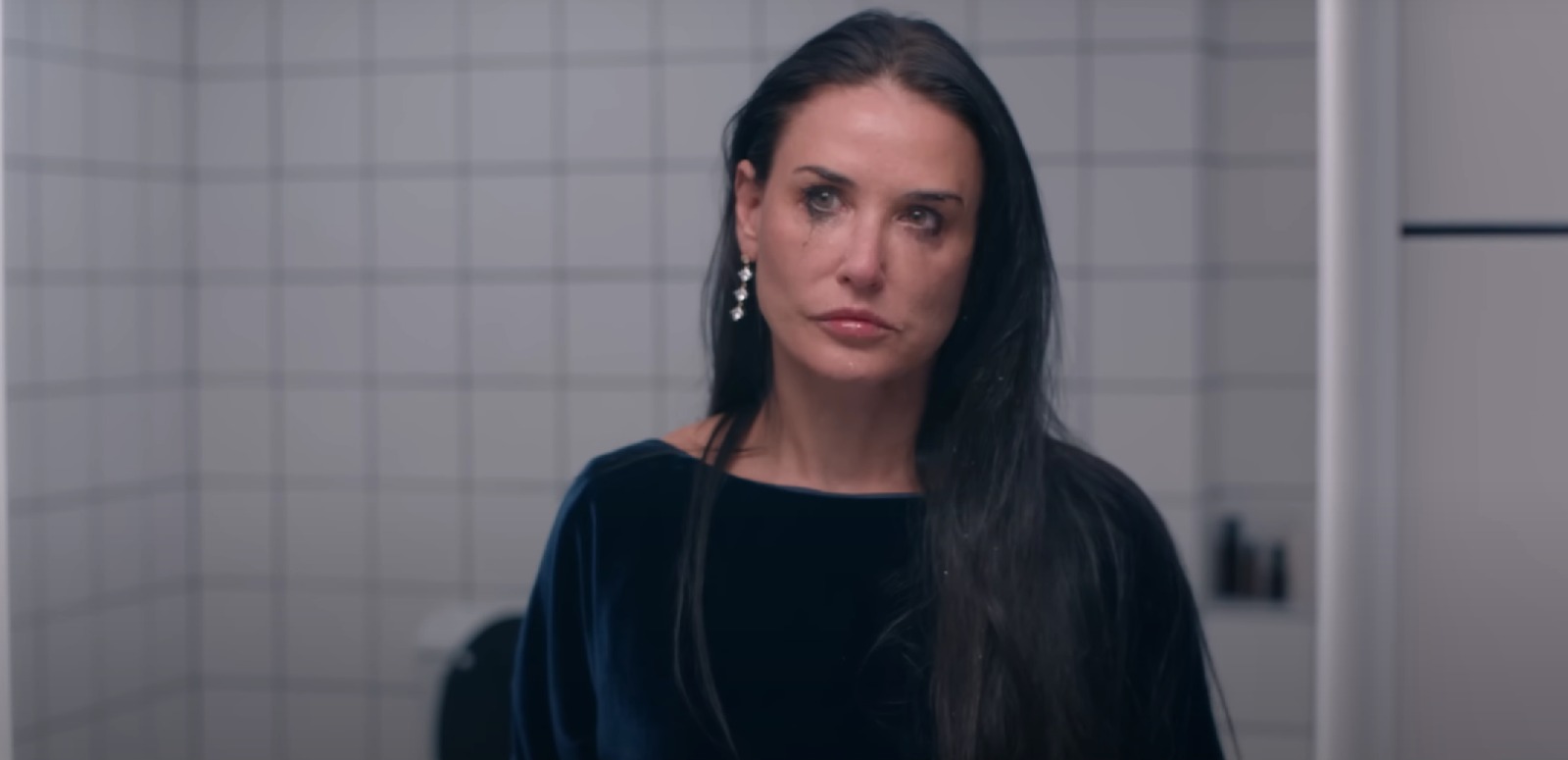The Substance (2024) is a film that arrives shrouded in the promise of “smart horror,” marketed as a psychologically intense thriller with profound themes and a refined aesthetic. At first glance, the movie seems to belong alongside the likes of Hereditary and Get Out—films that have redefined horror by balancing scares with intelligent social commentary and complex storytelling.
However, despite its polished exterior and ambition to fit into the “smart horror” category, The Substance ultimately thrives in campy territory, embracing exaggerated performances, outlandish plot twists, and stylized violence that are staples of a more playful horror subgenre. Beneath its sophisticated disguise, The Substance reveals itself as a film that is less about intellectual thrills and more about embracing the entertaining absurdity of horror cinema.
The Smart Horror Disguise

To understand the film’s campy essence, it’s essential first to dissect how The Substance constructs its “smart horror” façade. From its opening scenes, the movie seems to delve into psychological themes and moral questions. It touches on topics like identity, societal pressure, and humanity’s darker impulses, setting up the expectation of a narrative that will probe the depths of the human psyche.
The director employs atmospheric lighting, lingering silences, and carefully composed shots, all aimed at creating an air of introspection and tension. Dialogue between characters is often steeped in existential musings as if each line is meant to invite deeper thought and analysis.
These techniques and themes suggest a philosophical weight, creating the illusion of a layered story that seeks to make profound statements. Characters grapple with their sense of self, moral dilemmas, and questions about the nature of fear, all of which could potentially build toward something meaningful.
However, as the story progresses, it becomes clear that these themes are more surface-level than substantive. Instead of developing into a cohesive message, they serve as decoration, adding sophistication to the film’s atmosphere without truly shaping its narrative.
Furthermore, The Substance borrows several hallmarks of smart horror, such as cryptic imagery, ambiguous character motivations, and subtle foreshadowing, in ways that create a sense of mystery. These elements are typically used to support a deeper exploration of themes in smart horror films, where every scene and choice carries symbolic meaning.
In The Substance, however, these aspects feel less like carefully crafted symbols and more like a calculated attempt to dress up the film’s true nature. They suggest complexity but ultimately serve as a distraction from the story’s more chaotic and flamboyant heart.
The Campy Horror Reality

As the movie progresses, The Substance begins to reveal its campy soul. One of the clearest signs of this shift is in the acting style, which frequently edges toward melodrama. Characters react with exaggerated expressions and theatrical dialogue, heightening the intensity of each scene to the point where it becomes hard to take their emotions seriously.
Where smart horror typically leans toward restrained performances, inviting the viewer to feel unease through subtle character choices, The Substance opts for performances that are almost caricatured. The actors deliver their lines with an energy that feels closer to satire than genuine horror, embracing a larger-than-life quality that betrays the film’s true tone.
The plot, too, follows a trajectory more suited to camp than psychological horror. Where smart horror usually unfolds in a carefully paced narrative, building tension through small, meaningful developments, The Substance hurls the viewer into a series of increasingly absurd plot twists. Moments that should be harrowing often veer into the realm of the improbable, creating a sense of unpredictability that feels less like suspense and more like spectacle.
The twists arrive with little warning and often defy the story’s internal logic, amplifying the film’s chaotic energy. These plot choices add excitement but lack the coherence expected of smart horror, ultimately aligning more closely with the kind of exaggerated storytelling that defines camp.
Another hallmark of camp horror on full display in The Substance is its love of stylized violence and gore. Smart horror often exercises restraint with violence, using it sparingly and focusing instead on psychological dread. The Substance, by contrast, revels in drawn-out scenes of blood and destruction, pushing the limits of stylized horror.
The gore is excessive, with graphic close-ups and stylized effects that prioritize shock value over subtlety. This approach, while undeniably effective in thrilling the viewer, feels out of place in a movie that initially aims for intellectual horror. The violence in The Substance is too elaborate to be taken seriously, adding yet another layer of camp to the film’s aesthetic.
Why the Disguise Works

Given the film’s campy core, it’s worth considering why The Substance presents itself as a smart horror movie. This disguise is likely a deliberate choice, allowing the movie to appeal to a broader audience. By positioning itself as a serious psychological thriller, The Substance initially attracts viewers who might otherwise overlook a campy horror film. Once drawn in, these viewers are treated to a whirlwind of campy thrills and exaggerated horror, discovering that the film’s true charm lies in its playful approach to genre conventions.
Moreover, The Substance may be subtly satirizing the horror genre’s recent trend toward “elevated” horror. By masquerading as a smart horror movie, the film seems to make a statement about the pressures and expectations placed on modern horror to be intelligent, restrained, and thought-provoking.
As the movie strips away its intellectual façade and fully embraces camp, it challenges these expectations, suggesting that horror can still be entertaining and memorable without necessarily fitting into the “elevated” category. In a sense, The Substance is a self-aware homage to classic horror, paying tribute to the genre’s more playful roots even as it winks at contemporary horror trends.
In the end, The Substance stands out not as a profound psychological thriller, but as a campy horror movie dressed in sophisticated clothing. The film uses the trappings of smart horror to capture attention, only to reveal its true nature as a celebration of horror’s extravagant, over-the-top possibilities.
With exaggerated performances, improbable plot twists, and stylized gore, The Substance invites viewers to experience horror in a way that is as entertaining as it is outrageous. While some may be disappointed by the film’s lack of depth, others will find joy in its unapologetic embrace of camp. The Substance reminds us that horror need not be entirely serious to be compelling—sometimes, the most memorable horror films are those that allow us to revel in the thrill of the absurd.

Chaitanya Tuteja is someone who enjoys sharing his thoughts on books, movies, and shows. Based in India, he appreciates exploring different stories and offering honest reflections. When not reflecting on his favorite media, Chaitanya enjoys discovering new ideas and embracing life’s simple moments.

